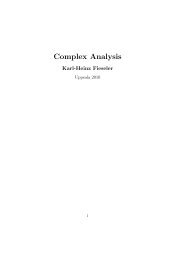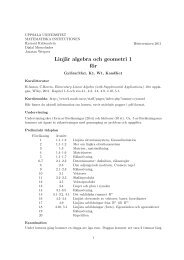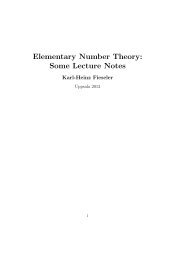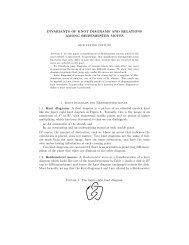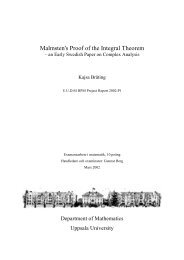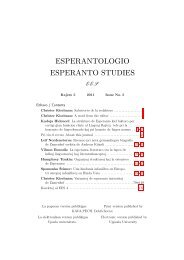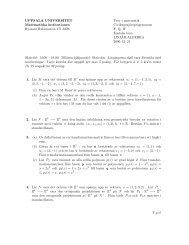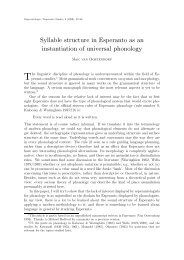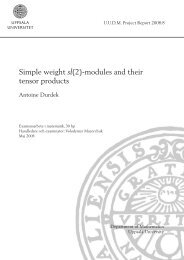Coherent homotopy commutative diagrams in algebraic topology ...
Coherent homotopy commutative diagrams in algebraic topology ...
Coherent homotopy commutative diagrams in algebraic topology ...
Create successful ePaper yourself
Turn your PDF publications into a flip-book with our unique Google optimized e-Paper software.
Figure 1:3.2 Weak <strong>homotopy</strong> typeMa<strong>in</strong> idea is to “measure” topological spaces by means of “nice” spaces, i.e.polyhedra. Let’s denote by CW the category of spaces hav<strong>in</strong>g the <strong>homotopy</strong>type of a polyhedron.Def<strong>in</strong>ition 1 A mapp<strong>in</strong>gf : X −→ Yis called a weak <strong>homotopy</strong> equivalence iffis a bijection for any P ∈ |CW|.[P, f] :[P, X] −→ [P, Y ]Theorem 2 (well known) For any space X there exists a polyhedron P and aweak <strong>homotopy</strong> equivalencef : P −→ X.For geometric topologists compact metric spaces are “good” (not “nice” likef<strong>in</strong>ite polyhedra).Example 3 (Warsaw, or Polish, circle)X =(Figure 1).(tends to the left l<strong>in</strong>e like y =s<strong>in</strong> 1 x ).Crucial argument:Ȟ ∗ (X, G) ≈ H ∗ (S 1 ,G).R 2 − X homeo≈ R 2 − S 1 .However, weak <strong>homotopy</strong> type of X is the po<strong>in</strong>t.2
3.4 Strong shape theory3.4.1 LocalizationDef<strong>in</strong>ition 5 A mapp<strong>in</strong>gf : X −→ Yis called a strong shape equivalence iffMap(f,P) :Map(Y,P) −→ Map(X, P)is a <strong>homotopy</strong> equivalence for any P ∈ |CW| where Map(X, P) is the simplicialset with mapp<strong>in</strong>gsX × ∆ n −→ Pas n-simplices (and with the evident face and degeneracy maps).Remark 6 f is a shape equivalence iff π 0 Map(f,P) is bijective for any P .Remark 7 It is enough to claim that π 0 Map(f,P) is bijective and that π 1 Map(f,P)is surjective.Remark 8 It is not known even for compact metric spaces whether any shapeequivalence is a strong shape equivalence.Analogously, a strong shape equivalence between pro-spaces is def<strong>in</strong>ed.Def<strong>in</strong>ition 9 (Marde˘síc ) The strong shape category SSH is a full subcategorySSH ⊆ pro − CWh(ss equivalences) −1iProposition 10 (Prasolov) For any category C,hpro − C ≈ <strong>in</strong>v − C (cof<strong>in</strong>al mapp<strong>in</strong>gs) −1i .Def<strong>in</strong>ition 11 (Prasolov)ThestrongshapecategorySSH is a full subcategorySSH ⊆ pro − CWh((cof<strong>in</strong>al mapp<strong>in</strong>gs) ∪ (level equivalences)) −1i3.4.2 B. GuntherGiven a space X, letX ↓ CW be a simplicial class, hav<strong>in</strong>g as simplices <strong>homotopy</strong><strong>commutative</strong> <strong>diagrams</strong> from X to polyhedra and coherent homotopiesX × I ? −→ P ?ThenX ↓ CW −→↓ CW4
is a so-called weak Kan fibration. Now, accord<strong>in</strong>g to Gunther, SSH has topologicalspaces as objects, and <strong>homotopy</strong> classes of mapp<strong>in</strong>gsY ↓ CW −→ X ↓ CWover ↓ CW as morphisms.However, it is possible to “richly” decategorize this construction. TakeP =(holim (K) :K ∈ X ↓ CW) ,and one gets a strong shape equivalenceX −→ P.This helps to prove that Gunther’s construction is equivalent to the Lisica-Marde˘sić ’(below).3.4.3 Lisica-Marde˘sićGiven a space X, letX −→ Pbe a strong shape equivalence whereP ∈ |pro − CW| .Such an equivalence always exists. Now, they def<strong>in</strong>e morphisms between Xand Y as coherent morphisms between correspond<strong>in</strong>g pro-objects P and Q.There is terribly difficult to def<strong>in</strong>e composition of such maps, to prove that thedef<strong>in</strong>ition does not depend on the choice of P and Q etc.3.5 ShekutkovskiLet X be a space, and letNU =(NU : U is a normal cover<strong>in</strong>g) .NU is not a strict pro-object, but rather a coherent one. One can def<strong>in</strong>e amapp<strong>in</strong>gX −→ NUwhich is not a strict mapp<strong>in</strong>g of pro-spaces. A lot of work is needed to def<strong>in</strong>emorphisms between corespond<strong>in</strong>g “coherent” pro-spaces, and to prove allnecessary properties. Shekutkovski published a number of papers with a lotof mistakes, and therefore his def<strong>in</strong>ition cannot be considered complete. Evenmore complicated is to def<strong>in</strong>e homology groups (see below).5
4 HomologyThe most natural def<strong>in</strong>ition of (ord<strong>in</strong>ary and extraord<strong>in</strong>ary) strong homologywas proposed by Edwards-Hast<strong>in</strong>gs and later by Batan<strong>in</strong>: given a spectrum E,letH ∗ (X, E) =π ∗ holim i ω ((X ∪ pt) ∧ E) .Lisica and Marde˘sić proposed an ord<strong>in</strong>ary strong homology us<strong>in</strong>g <strong>homotopy</strong>limits of cha<strong>in</strong> complexes. There are a lot of problems: functoriality, variousproperties, spectral sequences etc. One needs also to prove that, <strong>in</strong> the caseE = K(G),the def<strong>in</strong>ition above is equivalent to Lisica-Marde˘sić def<strong>in</strong>ition. That was doneby Prasolov [Pra01].5 Challenges• Def<strong>in</strong>e (topologically or multi-categorically) a coherent pro-space.• Def<strong>in</strong>e coherent morphisms between coherent pro-spaces.• Def<strong>in</strong>e a strong shape equivalence between coherent pro-spaces.• Def<strong>in</strong>e an (ord<strong>in</strong>ary or extraord<strong>in</strong>ary) homology for coherent pro-spaces6
References[Bat93] M. A. Batan<strong>in</strong>. <strong>Coherent</strong> categories with respect to monads andcoherent pro<strong>homotopy</strong> theory. Cahiers Topologie Géom. DifférentielleCatég., 34(4):279—304, 1993.[Bat97][CP97][EH76][Gün91]Mikhail A. Batan<strong>in</strong>. Categorical strong shape theory. Cahiers TopologieGéom. Différentielle Catég., 38(1):3—66, 1997.Jean-Marc Cordier and Timothy Porter. Homotopy coherent categorytheory. Trans. Amer. Math. Soc., 349(1):1—54, 1997.David A. Edwards and Harold M. Hast<strong>in</strong>gs. Čech and Steenrod <strong>homotopy</strong>theories with applications to geometric <strong>topology</strong>. Spr<strong>in</strong>ger-Verlag,Berl<strong>in</strong>, 1976. Lecture Notes <strong>in</strong> Mathematics, Vol. 542.Bernd Günther. Comparison of the coherent pro-<strong>homotopy</strong> theoriesof Edwards-Hast<strong>in</strong>gs, Lisica-Mardešić and Günther. Glas.Mat.Ser.III, 26(46)(1-2):141—176, 1991.[Gün92a] Bernd Günther. The use of semisimplicial complexes <strong>in</strong> strong shapetheory. Glas.Mat.Ser.III, 27(47)(1):101—144, 1992.[Gün92b] Bernd Günther. The Vietoris system <strong>in</strong> strong shape and stronghomology. Fund. Math., 141(2):147—168, 1992.[Mar00][MP98][Pra01]Sibe Mardešić. Strong shape and homology. Spr<strong>in</strong>ger Monographs <strong>in</strong>Mathematics. Spr<strong>in</strong>ger-Verlag, Berl<strong>in</strong>, 2000.Sibe Mardešić and Andrei V. Prasolov. On strong homology of compactspaces. Topology Appl., 82(1-3):327—354, 1998. Special volume<strong>in</strong> memory of Kiiti Morita.Andrei V. Prasolov. Extraord<strong>in</strong>ary strong homology. Topology Appl.,113(1-3):249—291, 2001. Geometric <strong>topology</strong>: Dubrovnik 1998.[Pra05] Andrei V. Prasolov. Non-additivity of strong homology. TopologyAppl., 153(2-3):493—527, 2005.[She01] Nikita Shekutkovski. From <strong>in</strong>verse to coherent systems. TopologyAppl., 113(1-3):293—307, 2001. Geometric <strong>topology</strong>: Dubrovnik 1998.[She04] Nikita Shekutkovski. Shift and coherent shift <strong>in</strong> <strong>in</strong>verse systems.Topology Appl., 140(1):111—130, 2004.[Str05] L. Stramaccia. Groupoids and strong shape. Topology Appl., 153(2-3):528—539, 2005.7




